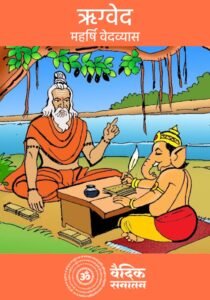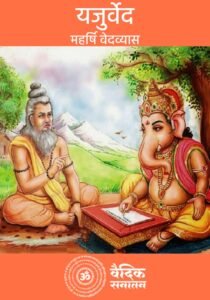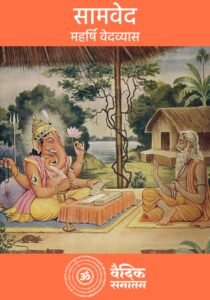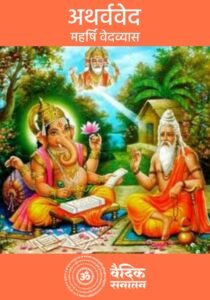The Vedas: Foundations of Eternal Knowledge in Sanatan Dharma
The Vedas are the most ancient and revered texts of Sanatan Dharma, more commonly known today as Hinduism. They represent not just religious scripture but also a vast body of spiritual, scientific, and philosophical knowledge that forms the bedrock of Indian civilization.
Composed in Vedic Sanskrit and transmitted orally for centuries, the Vedas are considered apauruṣeya—not authored by any human but revealed to ancient sages (rishis) through divine insight.
What Does “Veda” Mean?
The word “Veda” comes from the Sanskrit root “vid”, which means to know. Thus, Veda translates to “knowledge.” But this is not ordinary knowledge—it is divine wisdom, received during deep meditative states and passed down through generations with extreme precision.
The Vedas are part of the “Shruti” category of scriptures, which means “that which is heard.” This distinguishes them from “Smriti” (that which is remembered), such as the Mahabharata and the Puranas. Shruti is considered eternal, infallible, and of divine origin.
Origins of the Vedas
The exact timeline of the Vedas remains a subject of scholarly debate, but it is widely accepted that they were composed between 1500 BCE and 500 BCE. Traditional belief holds that the Vedas are timeless and were revealed at the beginning of creation. Some say the four faces of Lord Brahma, the creator in the Hindu Trinity (Trimurti), each recited one of the four Vedas.
In mythological narratives, different deities are credited with the revelation of the Vedas:
- Agni (fire) gave the Rigveda,
- Vayu (wind) gave the Yajurveda,
- Aditya (sun) gave the Samaveda,
- Atharvan rishi is associated with the Atharvaveda.
These texts were passed down orally for centuries through a meticulously maintained tradition of oral recitation, which employed methods such as padapatha (word-by-word recitation) and krama patha (sequential recitation) to ensure absolute precision.
The Four Vedas and Their Focus
The Vedas are traditionally classified into four distinct scriptures, each with a different emphasis but all forming a unified body of spiritual knowledge.
1. Rigveda – The Book of Hymns
The Rigveda is the oldest of the four and is composed entirely in verse. It consists of 1,028 hymns (suktas) and over 10,000 mantras, divided into 10 mandalas (books). The hymns are dedicated to various natural forces and deities such as Indra, Agni, Varuna, Soma, and Surya. These hymns express gratitude, invoke blessings, and explore the cosmic order. They offer a glimpse into the early Vedic worldview—filled with devotion, wonder, and a strong connection to nature.
2. Yajurveda – The Book of Rituals
The Yajurveda is a manual for rituals and sacrifices (yajnas). It consists of prose and verse mantras used by priests during fire ceremonies. This Veda is divided into two parts:
- Shukla Yajurveda (White Yajurveda)
- Krishna Yajurveda (Black Yajurveda)
The White Yajurveda presents the mantras clearly, while the Black Yajurveda intermingles mantras with commentary. The Yajurveda provides step-by-step procedures for offerings to deities and explains the symbolic meanings behind each rite.
3. Samaveda – The Book of Chants
The Samaveda is the Veda of melodies and music. It draws most of its verses from the Rigveda but is arranged for musical chanting during rituals. This Veda is important in the development of Indian classical music. It contains chants used in Soma sacrifice ceremonies, which were central to Vedic religious life. The spiritual purpose of the Samaveda lies in using sound vibrations to connect with the divine.
4. Atharvaveda – The Book of Spells and Healing
The Atharvaveda is unique among the four Vedas. It focuses on daily life, healing, ethics, and household rituals. It contains hymns, spells, incantations, and charms for protection against diseases, misfortunes, and evil spirits. This Veda reflects the shift from ritualistic practice to more practical concerns of ordinary life, such as marriage, farming, and medicine. It also contains some of the earliest ideas about Ayurveda, India’s traditional system of medicine.
Structure of Each Veda
Each Veda is divided into four layers that reflect the evolution from ritual to philosophy:
- Samhita – The core text, consisting of hymns and mantras.
- Brahmana – Commentary on rituals, their meanings, and procedures.
- Aranyaka – “Forest texts” for hermits and ascetics; they explore symbolic and philosophical ideas.
- Upanishads – Mystical and philosophical discourses that discuss topics like Brahman (Universal Reality), Atman (Self), karma, rebirth, and liberation (moksha).
While the Samhitas and Brahmanas are mostly ritualistic, the Upanishads represent a spiritual and philosophical climax. They gave rise to Vedanta, one of the most profound schools of Hindu philosophy.
Scientific and Cultural Contributions
Although primarily spiritual, the Vedas also encompass a wide range of scientific knowledge:
- Astronomy and mathematics (mention of zero, large numbers, calendars)
- Medicine (early roots of Ayurveda)
- Metallurgy and agriculture
- Ethics, statecraft, and economics
- Grammar and phonetics
The Vedic view treats the universe as a sacred, interconnected whole, where Dharma (cosmic law) governs both nature and human behavior. The pursuit of knowledge in the Vedas was not fragmented—it was holistic.
Preservation and Legacy
Despite their age, the Vedas have been preserved with astonishing accuracy. Thousands of Vedic manuscripts survive today. Notably:
- The Bhandarkar Oriental Research Institute in Pune holds over 28,000 Vedic manuscripts.
- UNESCO has recognized 30 Rigveda manuscripts as part of its Memory of the World heritage.
Even today, Vedic chanting is practiced in parts of India with traditional intonation and accents unchanged for millennia. These oral traditions are listed as Intangible Cultural Heritage by UNESCO.
Relevance Today
The Vedas continue to inspire spiritual seekers, scholars, and scientists alike. Their wisdom is not limited to religious ceremonies but extends to modern concerns:
Environmentalism: The Vedas emphasize harmony with nature.
Spiritual growth: They stress self-realization, meditation, and inner peace.
Social values: Teachings on truth, compassion, and discipline remain timeless.
While rituals may evolve, the core messages of the Vedas—unity of existence, divinity within all, and the path to liberation—remain eternally relevant.
Conclusion
The Vedas are not merely old religious texts—they are the living essence of India’s spiritual heritage. Their depth of knowledge, poetic beauty, and philosophical insight continue to guide millions. Understanding the Vedas is like peering into a mirror that reflects both the outer universe and the inner soul. In a world searching for balance, meaning, and peace, the Vedas offer an eternal light.
Interested in reading the original Vedas in Hindi or English?
Visit: https://vedicsanatana.com/download-vedas/
Read in hindi: https://vedicsanatana.com/vedas-in-hindi/
